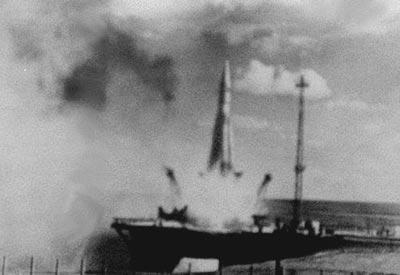Of myths and missiles: the truth about John F. Kennedy and the Missile Gapby Dwayne A. Day
|
| While it has long been known that the gap never existed, the myth that Kennedy was kept in the dark until he became president is still commonly repeated. It is not true. |
The public controversy was actually only the tip of the iceberg, for the real sparks flew within the American intelligence community, particularly between the US Air Force and the Central Intelligence Agency. Air Force analysts claimed that there could be hundreds of Soviet ICBMs, whereas CIA analysts argued that there were no more than a dozen.
We now know that there were only four.
Declassified CIA histories of the time have demonstrated that the gap was always a moving target—the numbers of deployed Soviet ICBMs that CIA and Air Force analysts argued over were constantly shifting. New intelligence data and new ways of interpreting that data did not initially resolve the dispute. The CIA was sporadically flying U-2 spy planes over the Soviet Union, but these missions could not photograph all Soviet territory. As long as unexamined territory remained, Air Force analysts—and Air Force generals like Curtis LeMay—insisted that large numbers of Soviet ICBMs could be located in unseen areas, therefore requiring large numbers of American ICBMs. Arcane arguments raged over how much floor space was required in Soviet missile factories to produce each missile.
This controversy leaked to the press, where Democrats argued that Republican President Dwight D. Eisenhower was not spending enough money on national security and was therefore placing the country in danger. In the 1960 election campaign John F. Kennedy echoed these charges—allegedly because he did not have access to the intelligence data.
Intelligence briefings
In July 1960 Senator Kennedy was provided an intelligence briefing about a broad array of subjects, including Soviet missile capabilities. Kennedy’s running mate, Lyndon Johnson, was also given a similar briefing at the time.
Director of Central Intelligence Allen Dulles summarized the briefings in a letter to President Eisenhower [PDF, 450KB] in early August 1960. The letter is contained in the Eisenhower Library and was declassified in 1976.
Dulles explained that he had briefed Kennedy on July 23 and Johnson on July 28 at their respective residences. Each briefing covered the same topics and lasted slightly over two hours.
“The two briefings covered the same general subject matter,” Dulles wrote. “Namely, recent developments in Sino-Soviet policy; an analysis of Soviet strategic attack capabilities in missiles and long-range bombers and of Soviet nuclear testing prior to the moratorium and the background of the RB-47 [aircraft shootdown] incident. This was followed by developments in the Berlin situation, in Cuba and the Congo and in other strategically important areas including the Middle East, Iran, the Formosa Straits, and Communist China; also NATO problems and France and Algeria.”
| A potentially lucrative line of inquiry for an intrepid historian would be to examine Kennedy’s speeches about national security before and after the briefing and see if they changed in any significant way. |
All of those subjects and areas were particularly hot at the time. Berlin was a potential flashpoint as American and Soviet tanks faced each other over barbed wire. “Both candidates were particularly interested in developments that might arise during the campaign, particularly with regard to Berlin, Cuba, and the Congo,” Dulles wrote. Cuba would be the site of a botched invasion attempt in April 1961, and the Berlin Wall would replace the barbed wire starting in August of the same year.
The Missile Gap was also a topic of discussion. “Following the briefing on Soviet missile developments, Senator Kennedy asked how we ourselves stood in the missile race. I replied that the Defense Department was the competent authority on this question and the Senator remarked that he hoped to see Secretary Gates and also expressed a desire to have a talk with Secretary Herter. I said that I would mention this to you which I had the opportunity of doing at the NSC Meeting on Monday, July 25.” Dulles added that “Senator Johnson, in addition to his particular interest in Soviet missile development, gave particular attention to developments in the Caribbean, including Mexico.”
Dulles closed his letter to Eisenhower by noting that both men gave brief statements to the press following the briefings. Kennedy was informal, whereas Johnson read a short statement that he showed to Dulles before he read it. Dulles also provided the statement to Eisenhower.
What the letter makes clear is that Kennedy was given a detailed intelligence briefing in the middle of the presidential campaign, including information on the Missile Gap. A potentially lucrative line of inquiry for an intrepid historian would be to examine Kennedy’s speeches about national security before and after the briefing and see if they changed in any significant way. For instance, did he tone down his comments about the supposed gap in ICBMs after he received the briefing?
Of course, this does not completely settle the matter. Improved intelligence, particularly the success of the first CORONA spy satellite mission in late August 1960, helped reduce the range of uncertainty about Soviet ICBM deployment. But it was not until a satellite mission in late 1961 that the intelligence community obtained definitive proof that there were no Soviet ICBMs filling vast areas of unexplored Siberia. As long as this uncertainty raged, Air Force generals could argue the worst-case scenario, and Kennedy could legitimately take their side in the argument, even if unbiased analysts at the CIA argued that claims of large Soviet ICBM deployments were based upon bad interpretations of available data. However, Kennedy was not ignorant of the intelligence data, at least not after July 1960. Hopefully in the future historians will probe this issue in greater depth.
